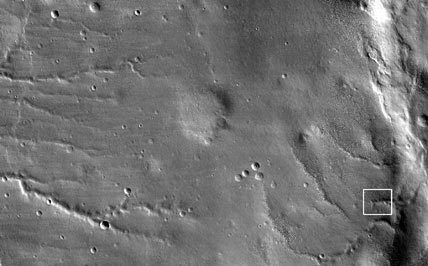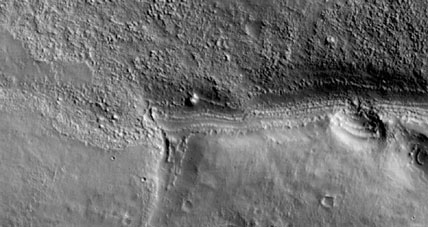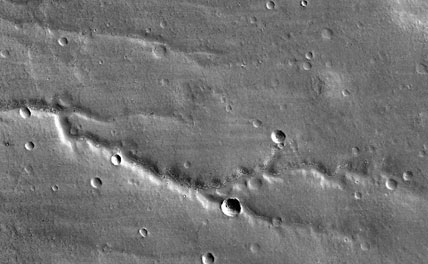
This is a low-resolution look at the test image by MRO's HiRISE camera. Drainage channels and craterlets mark this plain in Mars' southern highlands near the side of the Hellas basin. Sunlight is coming from the upper right. This view, a mosaic combining 10 side-by-side exposures taken through red filters, is 50 kilometers (30 miles) wide. The white box at lower right shows the position of a the full-resolution sample below. Click the image for a better view, or go to NASA's news article for the full-resolution version.
NASA / JPL / University of Arizona.
NASA's Mars Reconnaisance Orbiter (MRO), which successfully braked into Martian orbit on March 10th, has passed another test with flying colors. Even though the spacecraft is still in a very high, elongated orbit, its handlers gave its super-power camera, the High Resolution Imaging Science Experiment HiRISE), a tryout. "The quality of this test image is spectacular, with no hint to the eye of any smear or blurring," said the MRO team in a press statement. "A high signal-to-noise ratio reveals fine details even in the shadows."

This is a nearly full-resolution view of the area marked by the small white box on the first image; sunlight is coming from the upper right. Note the layering in the walls of the drainage channel. This scene is 4.5 kilometers (2.8 miles) wide. Even though this test image was shot from an altitude of 2,489 kilometers (1,547 miles), high above MRO's eventual mapping orbit, it has a resolution of 2.5 meters (98 inches) per pixel. The smallest objects of discernable shape are about 7.5 meters across. Click image for better view.
NASA / JPL / University of Arizona.
The HiRISE camera can take 40,000-by-20,000-pixel (about 800-megapixel) images through its 0.5-meter (20-inch) f/24 telescope. The craft will spend the next six months delicately aerobraking its way down to a low orbit. It will then begin mapping in earnest.
MRO is far more capable than any previous Mars mapper. The test images were shot from an altitude of 2,489 kilometers (1,547 miles); once in its final orbit at about a tenth this height, MRO should have a resolution of 30 centimeters (1 foot) per pixel on the ground. And its extremely large view will cover much more land area at high resolution than possible before. Great improvements are sure to result in our knowledge of Mars's geology, history, and a wide variety of surface conditions all over the planet.
"These images provide the first opportunity to test camera settings and the spacecraft's ability to point the camera with Mars filling the instruments' field of view," said Steve Saunders, the mission's program scientist, in a press statement. "The information learned will be used to prepare for the primary mission next fall." The test will help the camera team develop calibration and image-processing procedures, such the precise corrections needed for color imaging and for high-resolution surface measurements from stereo pairs of images.
For more information and the full-resolution view, see NASA's news release. More images from the test run should be released in the coming days.

Old drainage channels, underlying a smattering of younger craterlets, mark this detail from the main image. Sunlight is coming from the upper right.
NASA / JPL / University of Arizona.
 0
0
Comments
You must be logged in to post a comment.